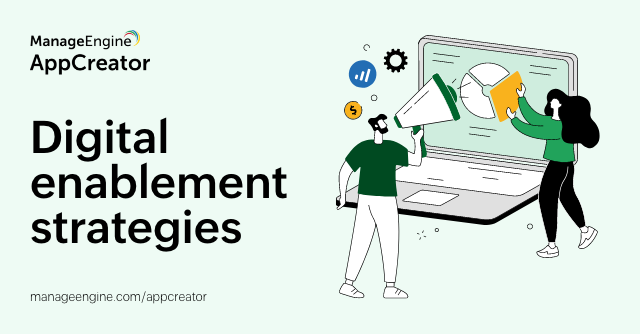- HOME
- Digital Transformation
- Digital enablement strategies: Facilitating digitization in organizations
Digital enablement strategies: Facilitating digitization in organizations
- Last Updated: May 27, 2024
- 200 Views
- 6 Min Read

Complete end-to-end digitization is becoming the norm for organizations. New advancements like generative pre-trained transformers, such as ChatGPT, herald the intersection of business process execution and technology. These technologies have fundamentally redefined the way organizations approach business execution, making their adoption mandatory for organizational viability. If you don't catch up with the digitization bandwagon, you will be left stranded.
To completely digitize an organization is no easy task. It requires a lot of planning, effort, and resources to execute. This is where digital enablement strategies come into the picture.
A digital enablement strategy helps organizations effectively harness technology, enabling them to usher in complete end-to-end digitization optimally.
The elements of digital enablement strategies
Digital transformation and digitization are no easy endeavors. There are several elements in an effective digital enablement strategy.
1. Implementing cutting-edge technologies
Technological advancements are constantly redefining the way business processes are executed today. Some examples of cutting-edge technologies are:
i) AI large language models: ChatGPT, Perplexity, and Google Gemini are some examples of large language models: advanced AI systems capable of understanding, generating, and manipulating human language. They can even generate computer code based on user input.
AI allows organizations to create highly responsive chatbots that resolve user queries instantly without human supervision.
ii) Quantum computing: Quantum computers are capable of solving problems that aren't possible using normal computers.
iii) Blockchain: Blockchain-based transactions are highly secure, and they form the backbone of cryptocurrencies.
To effectively implement cutting-edge technologies in organizations, sound digital enablement strategies are required.
2. Evangelizing digital fluency
When cutting-edge technologies are implemented in an organization, it is imperative that the organization's workforce is trained to use them. This includes creating central learning repositories, engaging with technical trainers to organize training programs for employees, and ensuring that the workforce is aware of how to extract the most out of cutting-edge technology.
3. Data mining to enable better decision-making
Business process execution generates vast swaths of data. By applying data mining principles, meaningful information can be unearthed from raw data. This enables organizations to make the right decisions backed by pertinent data.
4. Improving the customer experience
Leveraging technology to ensure that your end customer gets the best possible experience is vital. Using digital technologies, your customer's interactions with your organization can be enhanced right from the first touch, guaranteeing high degrees of satisfaction.
5. Seamless process automation
You can perform repetitive, mundane tasks like data entry and mass form filling automatically by using robotic process automation software. Having this handy tool in your arsenal allows you to replace manual labor with efficient, accurate, and digitized task and process execution. This ensures infallibility, improved efficiency, and enhanced productivity. It also enables organizational personnel to concentrate on more creative tasks instead of being occupied with mundane tasks.
6. Organizational agility
Digital enablement strategies foster a culture of innovation, also ensuring that digitization brings about enhanced organizational agility. This facilitates organizations to be agile and highly adaptable, equipping them with the right tools to remain relevant in the face of persistent change.
A 5-step plan to implement digital enablement
Step 1: Analyze where you presently stand
The first step is to thoroughly understand your current stance. This is where asking a few vital questions becomes important.
What is the current technical expertise of your personnel?
Which departments are lagging behind in terms of business competitiveness?
Which departments require a revamp?
Who are your prime competitors?
What does your competition do that you don't?
Answers to the above questions will show you where you stand in regard to organizational viability.
Step 2: Specify your vision and end goals
Digital enablement requires a well-defined vision and clear, actionable, and SMART (specific, measurable, achievable, realistic, timely) goals. Without this, you'll be shooting in the dark.
A well-thought-out, neatly laid plan for the digital enablement of your organization is essential. It is vital that your organization's stakeholders collaborate, elucidate, deliberate, and decide upon the vision for your digital transformation. A digital enablement strategy can only be effective when the vision and end goals for digitization are set with full clarity.
Step 3: Establish goals for the future
Next comes setting a continuous improvement plan for the future. When each iteration of digitization is completed, there needs to be a newer objective driving the metrics further upwards, setting in motion constant progress. This will ensure that digitization does not stagnate. To keep up with the pace of disruptive, innovative technologies that constantly surface, establishing goals for the future and constantly renewing them is vital.
Step 4: Execute the plan
Implement the digital enablement strategy in your organization. Involve all the stakeholders, get them up to date with the technologies you're harnessing, and support them in the digitization journey. Ensure that the transition is smooth.
Step 5: Get feedback, improve, and iterate
Once the first phase of the digital enablement strategy is executed, do not persist with the status quo. Ensure that you receive feedback from the strategy's execution to improve it for the next iteration.
The point is to create a feedback loop that will let you know which digital enablement strategies are working and which aren't, and to improve continuously with constant, real-time feedback.
This feedback loop will ensure that there is a cumulative improvement in the efficacy of your chosen digital enablement strategies.
A few examples of digital enablement strategies
Data analytics
Organizations can use digital enablement strategies powered by data analytics to create actionable information, fuel growth, and deduce inferences. Data sharing across organizational departments breaks down siloed infrastructure and promotes cohesive inter-departmental growth. This leads to increased organizational efficiency, productivity, and throughput. Bottlenecks are also removed this way.
Blockchain
Blockchain technology, the backbone of cryptocurrencies, can comprise a part of effective digital enablement strategies. Its secure nature allows it to be used in industries where data security is paramount. Healthcare, energy, regulatory compliance and reporting, and financial services and payments all stand to benefit from digital enablement strategies powered by blockchain technology.
Cybersecurity
Safeguarding consumer and organizational data is crucial. A well-thought-out digital enablement strategy should include effective security measures. Encrypting data at rest and during transmission is one example of a digital enablement strategy focused on assuring data security. Strategies should also ensure adherence to global security standards, such as the GDPR and the CCPA. There should also be mechanisms to detect and respond to security threads in real time.
DevOps
A strategy to streamline software engineering, maintenance, and deployment can assure constant improvement, increased developer productivity, organizational efficiency, and minimized chances of the occurrence of process-associated bottlenecks.
Low-code
Low-code platforms are an effective digital enablement strategy unto themselves. Their ability to develop applications with minimal coding (hence the name) and rapidly produce fully functional prototypes, and their inherent support for agile development methodologies, make them a viable candidate for digital enablement.
With low-code platforms, the whole domain of digital enablement is thrown open to any class of developer, be they professional or line-of-business users. What's more, with most low-code platforms, once you develop your applications on one platform—say, the web—they are instantly available on the iOS and Android platforms, too. This saves a lot of time and development effort that usually goes into developing multi-platform applications. Some examples of low-code platforms are the cloud-based Zoho Creator platform and the on-premises ManageEngine AppCreator platform.
Executing digital enablement strategies on low-code platforms is a very effective method of ensuring that your organization steers towards growth, profits, and increased customer satisfaction.
Click on the below button if you would like to evaluate the ManageEngine AppCreator low-code platform for implementing your digital enablement strategies.
Closing thoughts
Digital enablement strategies empower organizations to completely harness the capabilities and potential of digitization. With their varied components, the effectiveness of digital enablement strategies depends upon the way they are executed in an organization. A predefined and well-thought-out procedural approach to implementing these strategies will augur well for any organization that intends to benefit from them.




